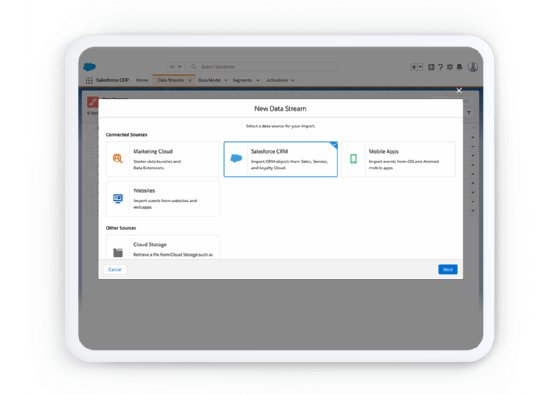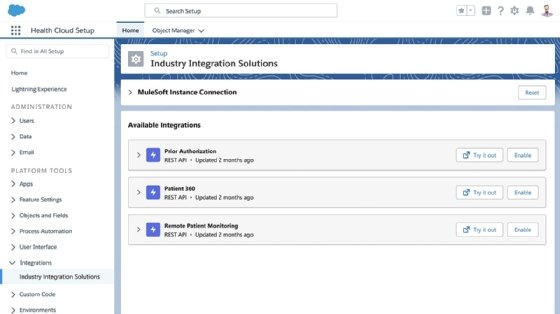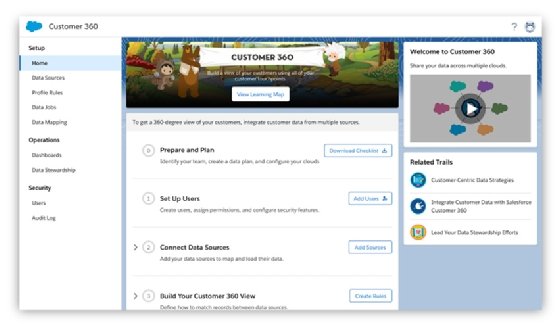Salesforce Customer 360
What is Salesforce Customer 360?
Salesforce Customer 360 is a collection of tools that connect Salesforce apps and create a unified customer profile with one view of the customer. Customer 360 goes beyond the capabilities of a traditional customer data platform (CDP). It extends the practices of customer relationship management (CRM) with consumer-scale data management and activation.
Customer 360 lets companies connect any app, data source or device across any cloud service and on-premises server. Salesforce describes Customer 360 as an integrated CRM platform.
Key features of Customer 360
Salesforce Customer 360 includes the following features and functionality:
Data unification and consent management. Businesses use Salesforce's Genie feature to unify all their customer data to create comprehensive customer profiles. This includes known and unknown data such as cookies and first-party IDs. With Salesforce's consent management framework, companies can get customer consent for email marketing and digital advertising.

Advanced audience segmentation. Customer segmentation capabilities let companies identify groups of people to engage with based on demographics, engagement history and other customer information. A business could identify women who like to run and are in the market for running wear based on their web browsing habits, emails interactions and previous purchases.
Personalized customer engagement. Once a company has identified an audience, it can activate customer data across marketing, commerce and service. This lets businesses deliver a unified, continuous experience to customers and prospective customers across all marketing channels and better meet customer expectations.
Optimization. Companies get a 360-degree view of their customer. This lets them better analyze and understand how and when to engage with customers. Customer profiles are continuously updated based on behaviors, such as clicking ads, browsing catalogs and buying products. Artificial intelligence helps target the right products and other recommendations, optimizing engagement. Customers use Salesforce Tableau and Einstein analytics to do this.
Enablement. This feature uses automation to suggest tasks based on data-driven insights to the sales team.
Chatbot. The Einstein bot engages with users through self-service portals. It can recommend content that answers prospective customers' questions, route queries to the appropriate sales representative and set up meetings.
Data integration. Salesforce Customer 360 includes MuleSoft Direct for Industry Cloud, an integration accelerator for different industries that enables workflow and data integration from applications those industries commonly use.

Benefits of Customer 360
There are several benefits to Salesforce Customer 360, including the following:
- Personalized customer experience. Customer 360 uses customer data to personalize the customer experience and tailor messaging to each customer.
- Scalability. Applications in the platform can be scaled up or down depending on an organization's needs. Components can be added and removed.
- Usability. Customer 360 is a low-code integrated CRM platform with high usability and a small learning curve.
- Unification. The Salesforce platform unifies customer data across applications, serving as the single source of truth.
- Integration. Customer 360 connects sales, service, marketing, commerce, IT and analytics in a single shared system. This approach makes it easier to bridge fragmented customer data across an organization and let companies deliver integrated customer engagement at scale.
- Collaboration. The Salesforce tools connect teams that use different capabilities, allowing different teams access to the same customer data and insights, breaking down information silos.
- Productivity. Automated enablement and simplified data intake features enhance sales reps' productivity.
- Customer satisfaction. Improved productivity and insights lets reps respond to customers faster and in more detail, creating a better customer experience.

Limitations of Customer 360
Despite its benefits, there are drawbacks to Customer 360, such as the following:
- Cultural challenges. Sales representatives who aren't accustomed to automation might distrust the insights Customer 360 provides or the tasks it performs.
- Data mismatch. Data field types can vary among applications; it can be tedious to map them to the fields Salesforce provides.
- Data integration difficulties. The Salesforce Genie tool can struggle to index new real-time data, along with previously indexed historical data.
- Cost. Salesforce Customer 360 can require additional customization of some services, which adds to the cost.
- No content management system. Unlike some competing platforms, Salesforce Customer 360 does not include a content management system.
- No free option. Salesforce Customer 360 platform does not provide a free option.
Salesforce Customer 360 use cases
Examples of use cases for Salesforce Customer 360 include the following:
Customer onboarding. Sales Cloud can be used to automate lead entry, improve productivity and reduce errors in the lead entry and assigning process.
Personalized service. Service Cloud integrates data from disparate systems, enabling more personalized customer services.
Behavior-driven marketing. Marketing Cloud facilitates marketing automation, social listening and engagement for better marketing campaigns.
Personalized e-commerce. Commerce Cloud builds custom storefronts and behaviorally informed customer journeys for a more personalized e-commerce experience.
Unified data. Coordinated data access among different departments lets them work together more effectively.
Real-world examples of how Salesforce Customer 360 used include the following:
- Ford. The automotive company divided itself into several business units focused on different business areas, such as combustion engines and electric vehicles. It used elements of Customer 360, including Sales Cloud and Marketing Cloud, to help break down data silos.
- L'Oreal. The beauty products company drove engagement and loyalty across its brands using Commerce Cloud. By analyzing customer shopping habits, L'Oreal made predictive product recommendations and increased sales significantly.
- MillerKnoll. The furniture company uses multiple facets of Customer 360 to share carbon emissions data across its commerce, marketing and service departments to help the company work toward its sustainability goals.
Customer 360 unifies CRM applications to simplify customer data collection, automation and collaboration across sales, marketing and IT teams. Learn the challenges of juggling multiple team collaboration apps and how companies can support them.







